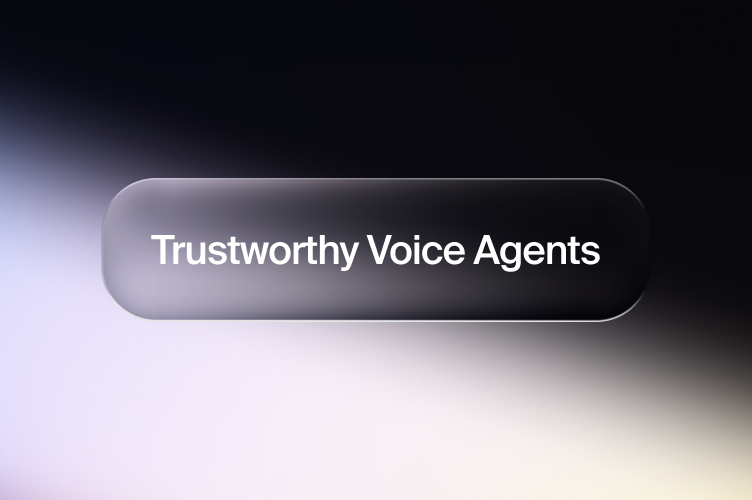Large language models are famously known to “hallucinate” facts, figures, and recommendations. And because voice AI systems rely on large language models to communicate naturally with customers, hallucinations are a serious consideration.
But for product managers, this isn’t purely a model problem. It has just as much to do with your overall architecture. How you capture audio, retrieve knowledge, constrain generation, and synthesize speech all influence how “safe” your agent actually is.
This post explores the full stack of voice agent safety, including the architectural considerations and necessary guardrails you need. And we’ll share some of the best practices we see from working with voice agent platforms every day.
Key takeaways
- LLMs are known to hallucinate responses. This is a serious compliance and reputational issue for voice agents offering customer support.
- These issues are more likely to come from a lack of boundaries and unclear prompts, rather than issues with the models themselves.
- Voice agent providers must build systems and processes that let client companies set up guardrails. Crucially, voice agents should reference accurate, up-to-date policies, and know when to bring in human agents if in doubt.
Why safety matters in voice AI
“Safety” for voice agents is about building trust, protecting users, and ensuring the business stays in control. A safe voice agent is one that:
- Stays grounded in verified information (and avoids fabrications)
- Operates within clearly defined guardrails
- Knows when to hand matters off to human agents
- Keeps an auditable record of its conversations with customers
- Evolves responsibly through testing and feedback
These are essentially the same practices you want to see from your human agents, too. But AI systems can operate at enormous scale, and you ultimately won’t have the same level of oversight as you would with employees.
The risks of unsafe or faulty voice AI can include:
- Brand damage from off-script or inappropriate responses
- Loss of customer trust if the agent gets basic facts wrong
- Compliance violations from missing required disclaimers or inventing answers
- Escalated support costs if customers end up calling back to clarify or complain
- Slow internal adoption if product or sales teams don’t trust the AI to behave predictably
The bottom line: for teams building voice tools, safety is a product quality issue. And it’s a clear prerequisite for deploying AI voice agents in real-world environments.
What does “unsafe” voice AI look like in practice?
Let’s look now at some of the most common safety issues with voice AI agents. Left unchecked, their impact can range from bad reviews and reputational damage, to more serious financial harm or compliance breaches.
We’ll examine these in detail first, then offer clear actionable steps to prevent or overcome them in the following section.
Hallucinated answers
These are generative AI’s best-known flaw: confident, plausible-sounding responses that are simply wrong. A voice agent might invent a refund policy, misquote a price, or provide legally inaccurate information.
When agents “freelance” or go off-script, they may offer guarantees, answer questions beyond their knowledge base, or stray into territory they’re not authorized to handle. This often happens when prompts are too vague or scope boundaries aren’t clearly enforced.
Hallucinations are especially risky in voice AI because these tools are becoming so natural. Customers may not even realize they’re dealing with a machine, and are likely to trust advice just as they would from a human agent.
Off-brand or non-compliant language
Organizations spend significant energy teaching service reps, managers, and senior executives how to communicate in the “company voice.” And without clear brand guidelines, voice agents may adopt the wrong tone in their conversations with clients.
Voice agents that sound overly casual, robotic, sarcastic, or even inappropriate can quickly erode trust. No company wants to see its customer interactions all over social media. And attempting to blame issues on rogue AI is perhaps even worse than if a human agent had strayed.
More worryingly, even minor language deviations can create legal risk in regulated industries. Agents may skip required disclosures or misrepresent information, and expose companies to significant repercussions.
Robust training is required to ensure AI voice agents fulfill the company’s legal obligations, and communicate with the same brand voice you’ve spent years honing.
Failure to escalate or hand off appropriately
Safety concerns can also result from silence or a lack of action. If a voice agent doesn’t know when to stop, or doesn’t recognize when a human should take over, it can leave customers stuck, angry, or unsupported in sensitive situations.
Good voice agents have both “voice activity detection” (VAD) and turn-taking models built in. These help the tool understand when the other person is taking a natural pause in their sentence, or waiting for a response.
Lack of transparency and traceability
Many voice tools don’t offer clear logs or insight into what the agent said, why it said it, or what data it used. That makes it harder to debug issues, perform QA, or prove that all compliance rules were followed. When serious issues do arise, companies need to know that they can easily review each interaction.
The broad concern here is control. The great advantages of voice AI are efficiency and scalability. But with that comes the necessary worry that nobody can monitor every conversation.
You need to ensure that voice agents stay grounded in truth, aligned with brand standards, and are capable of handling edge cases responsibly. And crucially, you should be able to look back through conversations to spot issues, or ensure every box was ticked correctly.
What creates risk in voice AI?
Hallucinations may feel like “LLM magic gone wrong.” But they usually point to predictable system design gaps. Understanding the root causes helps you prevent them before they show up in production.
Most voice agent hallucinations originate from one or more of the following:
- Lack of grounding in reliable data. Without access to source-of-truth systems like a company’s CRM, policy documents, or knowledge base, the model will simply guess based on general training data. This leads to plausible but incorrect statements.
- Loose or overly generic prompts. Open-ended prompts like “Answer this customer question” invite the model to overreach. Unless you tightly define the agent’s role, scope, and response rules, it’s likely to drift and fabricate.
- Poor speech-to-text tools. Voice agent success relies on understanding what customers say in real time. Noisy environments, accents or multilingual conversations, and custom vocabulary or industry jargon can all create misunderstandings from the beginning. These then spiral as the voice agent tries to keep up.
- Over-reliance on memory. Some systems try to maintain long conversational memory across multiple turns, which can backfire if earlier context is misunderstood or misremembered. Especially in asynchronous or multi-turn support calls, memory should be treated carefully.
- Lack of real-time constraints or retrieval. When a model isn’t constrained by logic (only answer from this source) or can’t fetch fresh data from a real-time API, it will fill in the blanks.
- Insufficient fallback design. Without a clear I don’t know path or escalation logic, hallucination becomes the default. The model always tries to respond and help, even when it shouldn’t.
These aren’t model problems, they’re architecture problems. That’s good news, because it means they can be solved with better design.
Crucial voice AI guardrails
Preventing hallucinations and unsafe voice AI isn’t about stifling creativity. It’s about precision, predictability, and control. That means building thoughtful guardrails at every layer: systems, processes, and policies.
System-level guardrails
- Use retrieval-augmented generation (RAG). Connect the LLM to a trusted knowledge base or real-time data source. This ensures responses are grounded in your actual business content, not public training data.
- Choose a best-in-class STT API. The quality of each conversation depends on your voice agent understanding real-time conversations without issues. The best STT models are both fast and highly accurate. They also deal seamlessly with background noise, accents, and language switching.
- Constrain generation parameters. Keep temperature low (for predictable answers), and define tight max tokens per turn to avoid overlong or speculative responses.
- Restrict scope through prompts and APIs. Be explicit about what the voice agent can and cannot say or do. Reinforce this with prompt engineering, pre-built intents, and controlled access to APIs.
Process-level guardrails
- Define fallback paths. Not every question needs an answer. Design I don’t know flows, handoff triggers, and clear escalation logic.
- Design for interrupts and error recovery. Voice users will talk over the agent, get frustrated, or ask off-topic questions. Use real-time barge-in detection to pause or adapt the agent’s response, and context-aware dialogue management to gracefully handle off-topic, emotional, or unexpected inputs with empathy and redirection.
- Audit and QA every release. Regularly review call transcripts, hallucination rates, and unexpected model behavior. QA shouldn’t stop at launch.
Policy-level guardrails
- Hard-code redlines. Prevent responses that break compliance rules, brand voice, or legal boundaries. These rules should live outside the model and be enforced at the orchestration level.
- Implement live supervision and alerts. In high-risk use cases (like healthcare or finance), supervisors should be able to monitor conversations and step in when needed.
Guardrails are a critical aspect of working with generative AI. We want these tools to have a level of freedom and to “think” for themselves, but always within set boundaries.
5 key factors for safer voice AI
To build reliable, safe, and useful agents, you need a full-stack approach with every layer designed for accuracy, speed, and oversight. Building on the systems and processes outlined above, here are five essential elements of your voice AI stack you need to handle correctly.
1. Best-in-class real-time speech-to-text (STT)
If your transcription is off, everything downstream suffers. Misheard words prevent accurate intent recognition, lead to irrelevant responses, or worse, cause the LLM to hallucinate in an effort to make sense of the input.
Look for STT that supports multilingual conversations, handles accents, and is highly accurate while also offering low latency.
2. Intent detection and dialogue orchestration
Before handing things off to the LLM, the system should first check: Is this a known intent? A compliance red flag? A task I can handle without generation?
This orchestration layer acts as a smart filter. It offloads known cases to rule-based tools and escalates more complex requests to the LLM, and to human agents where necessary.
3. Retrieval layer
You should be using retrieval-augmented generation (RAG). This lets the voice agent query a trusted knowledge base, FAQ system, or structured API in real time. The LLM has factual grounding to answer with precision and context, rather than guessing based on training data.
But not all retrieval is created equal. You need:
- Fast queries. If your retrieval system takes more than a second or two, you risk breaking the natural rhythm of the interaction. Latency at this step reduces the perceived intelligence of the agent, and can turn customers off.
- Scoped knowledge. Let’s say your agent is for a telecom provider. It should only search documents, products, and policies that apply to that provider—not general web data or competitor docs.
- Version control. If the source content changes (a new return policy is published, for example) you should be able to trace exactly which version the model was using at the time of any interaction. This is critical for debugging, support, and compliance reviews.
With a good retrieval layer, the voice agent can pull the latest policy from the help center, extract the right answer, and pass it to the LLM to be rephrased naturally. This ensures both accuracy and the right tone.
4. LLM runtime (with constraints)
To keep responses safe and on-brand, configure your LLM with:
- Low temperature: This controls randomness. A lower temperature (0.2–0.3) reduces hallucinations by making the model more deterministic and focused.
- Tight prompts: Don’t just ask the model to “answer the question.” Instead, define its role, tone, and boundaries. And allow the model to say “I don’t know” if appropriate.
- Rules and fallback logic: Include explicit instructions for what the model should not say or do. If it hits an edge case, redirect it to escalate or clarify rather than improvise.
Without constraints, a voice agent might confidently make up refund policies or suggest actions the company doesn’t support. With constraints, it instead says, “I’m not sure—I’ll connect you with a human agent to help.”
5. Speech synthesis and voice UX
Once a response is ready, it’s synthesized into speech. This final step dictates how the user experiences the AI.
It’s not just about clarity—it’s about pacing, tone, and timing.
- Pacing: If the voice talks too slowly, it sounds robotic. Too fast, and it feels rushed or hard to follow.
- Prosody: The rhythm and intonation of the voice impacts whether users feel like they’re talking to something smart—or something stilted.
- Interruptibility: Can users jump in mid-sentence to clarify or redirect, like they would with a person?
Over time, teams can refine the voice UX by tuning synthesis parameters, customizing prompts for speech synthesis, or even using emotional cues tied to sentiment analysis from the STT layer.
Real-world examples of safeguards in voice AI
So what does all this look like in production? Here are a few trends we’re seeing from companies putting safety first.
Intent-first voice flows
Some teams limit LLM use to fallback situations only. First, the voice agent tries to match the query to a known intent or workflow. Only when it fails does it use generative tools. This makes the system more predictable and easier to monitor.
Agent summarization with humans in the loop
Instead of having the LLM talk directly to the user, it generates summaries, call notes, or suggested responses for a human agent to review. The voice AI agent handles most of the heavy lifting, but doesn’t interact autonomously.
RAG + redaction in sensitive fields
In sectors like healthcare or finance, teams are combining RAG with automatic redaction to ensure that personally identifiable information (PII) is removed from context before it reaches the model. This protects privacy without compromising helpfulness.
Live supervision with risk alerts
In high-risk environments, real-time alerts can notify supervisors if the agent enters an unknown topic, stalls too long, or fails to de-escalate. This helps humans intervene early—before a bad experience or compliance issue occurs.
Ongoing hallucination audits
The best teams treat safety as continuous QA. They run regular audits to track hallucination frequency and types, then refine prompts, workflows, or retrieval sources based on what they learn.
Metrics and monitoring for trust
Building a safe voice agent requires a continuous cycle of tracking, learning, and refining. To sustain trust over time, you need clear metrics that reflect not just how the agent performs, but how safely and reliably it does so.
Here’s how leading teams approach monitoring.
Track safety-specific KPIs
Operational dashboards should go beyond NPS or resolution rate. To understand and improve voice AI trustworthiness, prioritize metrics like:
- Hallucination flags. Count and categorize instances where the agent gives inaccurate or made-up responses. This can be human-tagged or flagged through heuristics like “confident answers with no matching source.”
- Fallback frequency. How often does the agent default to “I’m not sure” or escalates? High fallback can mean safety is working. But too much may signal missed opportunities or overly tight constraints.
- Escalation rate. Track how often conversations require hand-off to human agents, and whether it’s due to confusion, policy boundaries, or technical limits.
- Retrieval coverage – What percentage of user questions successfully pull context from your knowledge base? Gaps here often lead to hallucinations.
Use human-in-the-loop feedback
Even with great automation, human review is essential for training and QA. Best practices include:
- Sampling live calls for annotation. Especially edge cases or low-confidence responses.
- Real-time agent feedback. Let agents or QA staff flag when an AI suggestion was helpful, off-base, or misleading.
- In-product reporting tools. Give customers or staff a quick way to mark “this answer was wrong” or “this sounded off,” creating a feedback loop for retraining.
Align hallucination monitoring with product QA processes. Think of it like regression testing—every change to content, prompts, or models should be monitored for impact on safety KPIs.
Good voice agents rely on great STT
The fundamental first step of any AI-powered conversation is first understanding what the customer wants and needs. Accurate, fast, and context-aware transcription is the foundation for everything that follows.
That’s where Gladia can help. Our industry-leading STT API delivers:
- Sub-300ms latency for real-time transcription
- Fluency in 40+ languages, with smooth handling of uncommon accents and code-switching
- Strong real-time performance in noisy, low-bitrate, or overlapping speech environments
- Custom vocabulary for domain-specific and technical language
With low-latency, high-accuracy speech-to-text, Gladia lets you ground every voice interaction in clean, contextual, and multilingual input.
Ready to build voice AI your customers can trust? Learn more here.




.png)


